tire type DODGE CHALLENGER 2018 Vehicle Warranty
[x] Cancel search | Manufacturer: DODGE, Model Year: 2018, Model line: CHALLENGER, Model: DODGE CHALLENGER 2018Pages: 316, PDF Size: 3.15 MB
Page 209 of 316
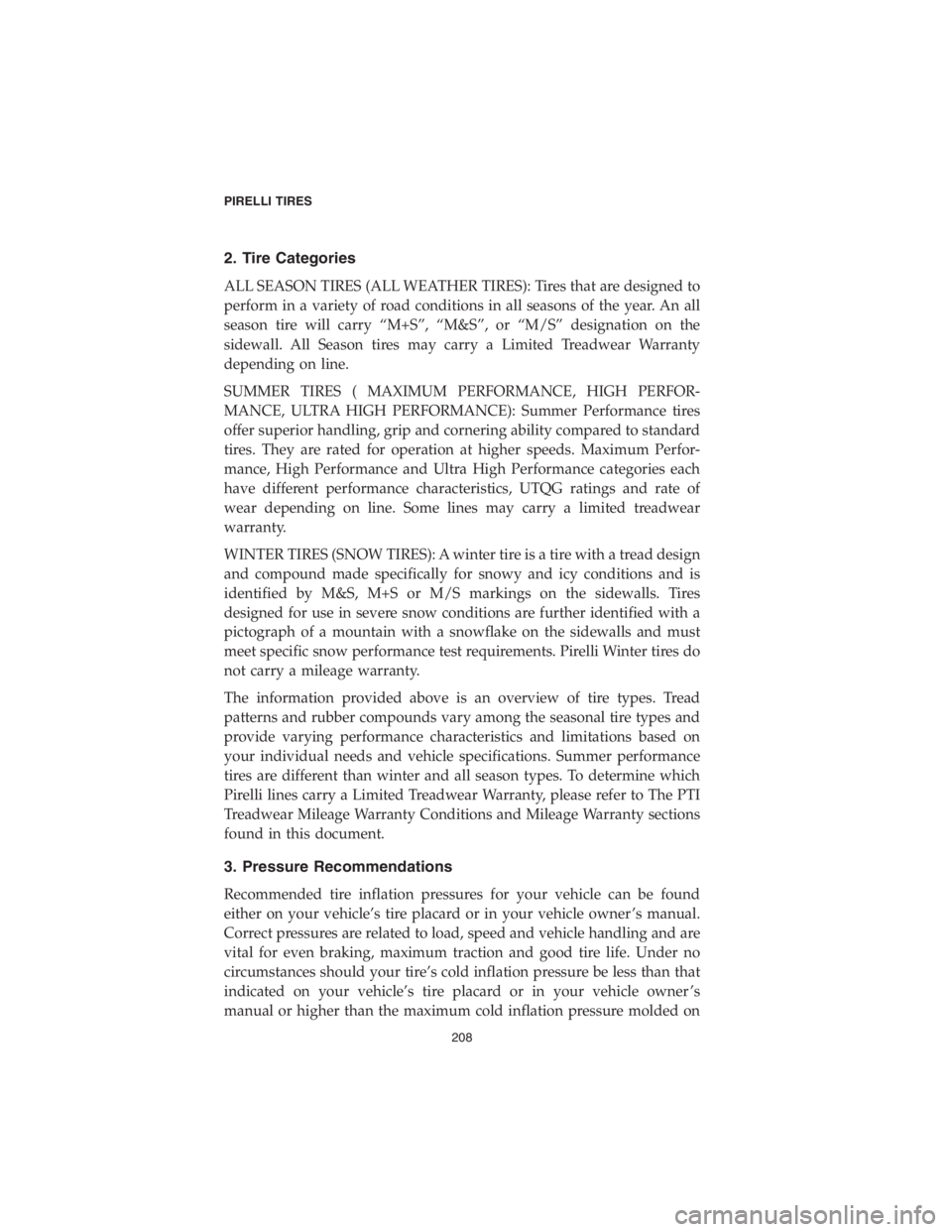
2. Tire Categories
ALL SEASON TIRES (ALL WEATHER TIRES): Tires that are designed to
perform in a variety of road conditions in all seasons of the year. An all
season tire will carry “M+S”, “M&S”, or “M/S” designation on the
sidewall. All Season tires may carry a Limited Treadwear Warranty
depending on line.
SUMMER TIRES ( MAXIMUM PERFORMANCE, HIGH PERFOR-
MANCE, ULTRA HIGH PERFORMANCE): Summer Performance tires
offer superior handling, grip and cornering ability compared to standard
tires. They are rated for operation at higher speeds. Maximum Perfor-
mance, High Performance and Ultra High Performance categories each
have different performance characteristics, UTQG ratings and rate of
wear depending on line. Some lines may carry a limited treadwear
warranty.
WINTER TIRES (SNOW TIRES): A winter tire is a tire with a tread design
and compound made specifically for snowy and icy conditions and is
identified by M&S, M+S or M/S markings on the sidewalls. Tires
designed for use in severe snow conditions are further identified with a
pictograph of a mountain with a snowflake on the sidewalls and must
meet specific snow performance test requirements. Pirelli Winter tires do
not carry a mileage warranty.
The information provided above is an overview of tire types. Tread
patterns and rubber compounds vary among the seasonal tire types and
provide varying performance characteristics and limitations based on
your individual needs and vehicle specifications. Summer performance
tires are different than winter and all season types. To determine which
Pirelli lines carry a Limited Treadwear Warranty, please refer to The PTI
Treadwear Mileage Warranty Conditions and Mileage Warranty sections
found in this document.
3. Pressure Recommendations
Recommended tire inflation pressures for your vehicle can be found
either on your vehicle’s tire placard or in your vehicle owner ’s manual.
Correct pressures are related to load, speed and vehicle handling and are
vital for even braking, maximum traction and good tire life. Under no
circumstances should your tire’s cold inflation pressure be less than that
indicated on your vehicle’s tire placard or in your vehicle owner ’s
manual or higher than the maximum cold inflation pressure molded on
PIRELLI TIRES
208
Page 212 of 316
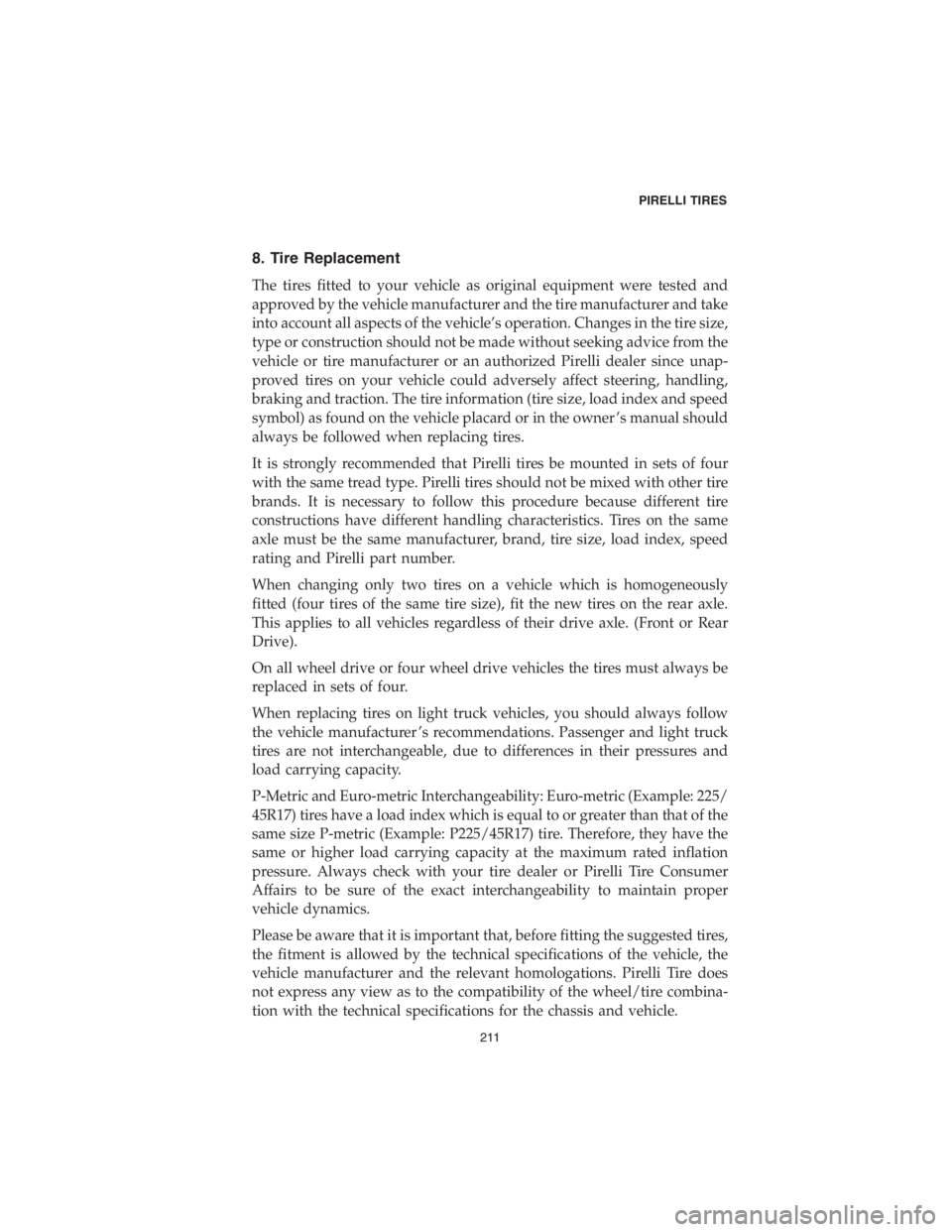
8. Tire Replacement
The tires fitted to your vehicle as original equipment were tested and
approved by the vehicle manufacturer and the tire manufacturer and take
into account all aspects of the vehicle’s operation. Changes in the tire size,
type or construction should not be made without seeking advice from the
vehicle or tire manufacturer or an authorized Pirelli dealer since unap-
proved tires on your vehicle could adversely affect steering, handling,
braking and traction. The tire information (tire size, load index and speed
symbol) as found on the vehicle placard or in the owner ’s manual should
always be followed when replacing tires.
It is strongly recommended that Pirelli tires be mounted in sets of four
with the same tread type. Pirelli tires should not be mixed with other tire
brands. It is necessary to follow this procedure because different tire
constructions have different handling characteristics. Tires on the same
axle must be the same manufacturer, brand, tire size, load index, speed
rating and Pirelli part number.
When changing only two tires on a vehicle which is homogeneously
fitted (four tires of the same tire size), fit the new tires on the rear axle.
This applies to all vehicles regardless of their drive axle. (Front or Rear
Drive).
On all wheel drive or four wheel drive vehicles the tires must always be
replaced in sets of four.
When replacing tires on light truck vehicles, you should always follow
the vehicle manufacturer ’s recommendations. Passenger and light truck
tires are not interchangeable, due to differences in their pressures and
load carrying capacity.
P-Metric and Euro-metric Interchangeability: Euro-metric (Example: 225/
45R17) tires have a load index which is equal to or greater than that of the
same size P-metric (Example: P225/45R17) tire. Therefore, they have the
same or higher load carrying capacity at the maximum rated inflation
pressure. Always check with your tire dealer or Pirelli Tire Consumer
Affairs to be sure of the exact interchangeability to maintain proper
vehicle dynamics.
Please be aware that it is important that, before fitting the suggested tires,
the fitment is allowed by the technical specifications of the vehicle, the
vehicle manufacturer and the relevant homologations. Pirelli Tire does
not express any view as to the compatibility of the wheel/tire combina-
tion with the technical specifications for the chassis and vehicle.
PIRELLI TIRES
211
Page 214 of 316
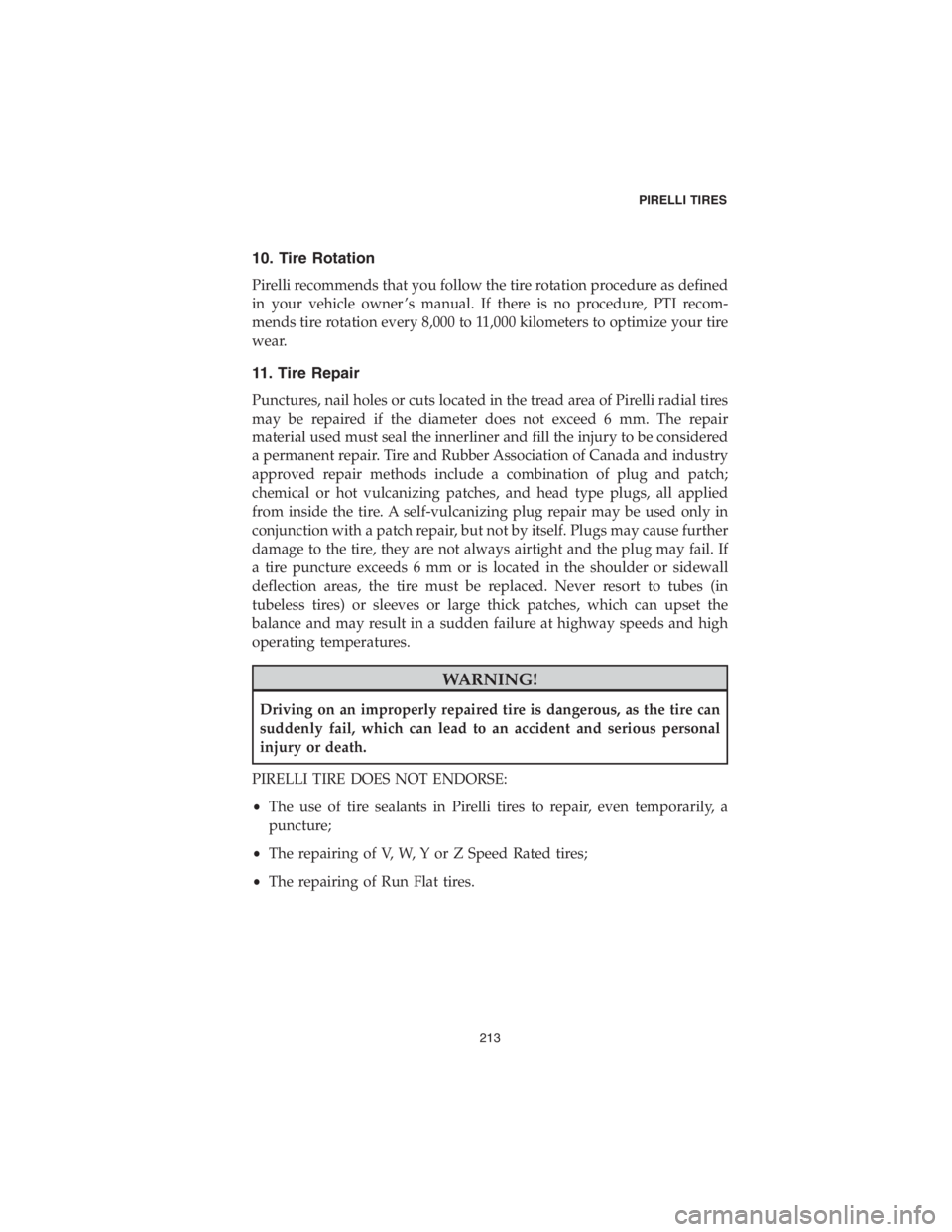
10. Tire Rotation
Pirelli recommends that you follow the tire rotation procedure as defined
in your vehicle owner ’s manual. If there is no procedure, PTI recom-
mends tire rotation every 8,000 to 11,000 kilometers to optimize your tire
wear.
11. Tire Repair
Punctures, nail holes or cuts located in the tread area of Pirelli radial tires
may be repaired if the diameter does not exceed 6 mm. The repair
material used must seal the innerliner and fill the injury to be considered
a permanent repair. Tire and Rubber Association of Canada and industry
approved repair methods include a combination of plug and patch;
chemical or hot vulcanizing patches, and head type plugs, all applied
from inside the tire. A self-vulcanizing plug repair may be used only in
conjunction with a patch repair, but not by itself. Plugs may cause further
damage to the tire, they are not always airtight and the plug may fail. If
a tire puncture exceeds 6 mm or is located in the shoulder or sidewall
deflection areas, the tire must be replaced. Never resort to tubes (in
tubeless tires) or sleeves or large thick patches, which can upset the
balance and may result in a sudden failure at highway speeds and high
operating temperatures.
WARNING!
Driving on an improperly repaired tire is dangerous, as the tire can
suddenly fail, which can lead to an accident and serious personal
injury or death.
PIRELLI TIRE DOES NOT ENDORSE:
•The use of tire sealants in Pirelli tires to repair, even temporarily, a
puncture;
•The repairing of V, W, Y or Z Speed Rated tires;
•The repairing of Run Flat tires.
PIRELLI TIRES
213
Page 215 of 316
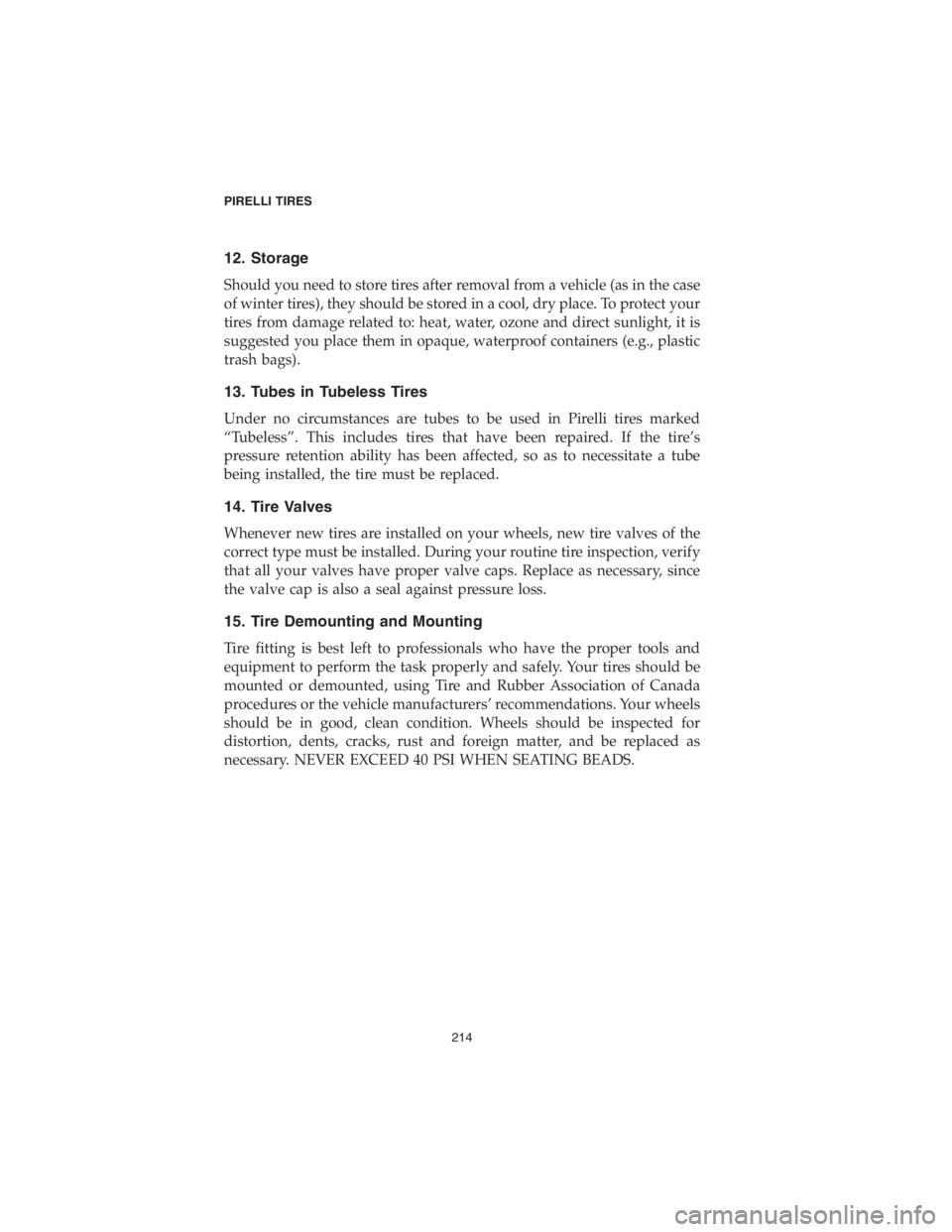
12. Storage
Should you need to store tires after removal from a vehicle (as in the case
of winter tires), they should be stored in a cool, dry place. To protect your
tires from damage related to: heat, water, ozone and direct sunlight, it is
suggested you place them in opaque, waterproof containers (e.g., plastic
trash bags).
13. Tubes in Tubeless Tires
Under no circumstances are tubes to be used in Pirelli tires marked
“Tubeless”. This includes tires that have been repaired. If the tire’s
pressure retention ability has been affected, so as to necessitate a tube
being installed, the tire must be replaced.
14. Tire Valves
Whenever new tires are installed on your wheels, new tire valves of the
correct type must be installed. During your routine tire inspection, verify
that all your valves have proper valve caps. Replace as necessary, since
the valve cap is also a seal against pressure loss.
15. Tire Demounting and Mounting
Tire fitting is best left to professionals who have the proper tools and
equipment to perform the task properly and safely. Your tires should be
mounted or demounted, using Tire and Rubber Association of Canada
procedures or the vehicle manufacturers’ recommendations. Your wheels
should be in good, clean condition. Wheels should be inspected for
distortion, dents, cracks, rust and foreign matter, and be replaced as
necessary. NEVER EXCEED 40 PSI WHEN SEATING BEADS.
PIRELLI TIRES
214
Page 232 of 316
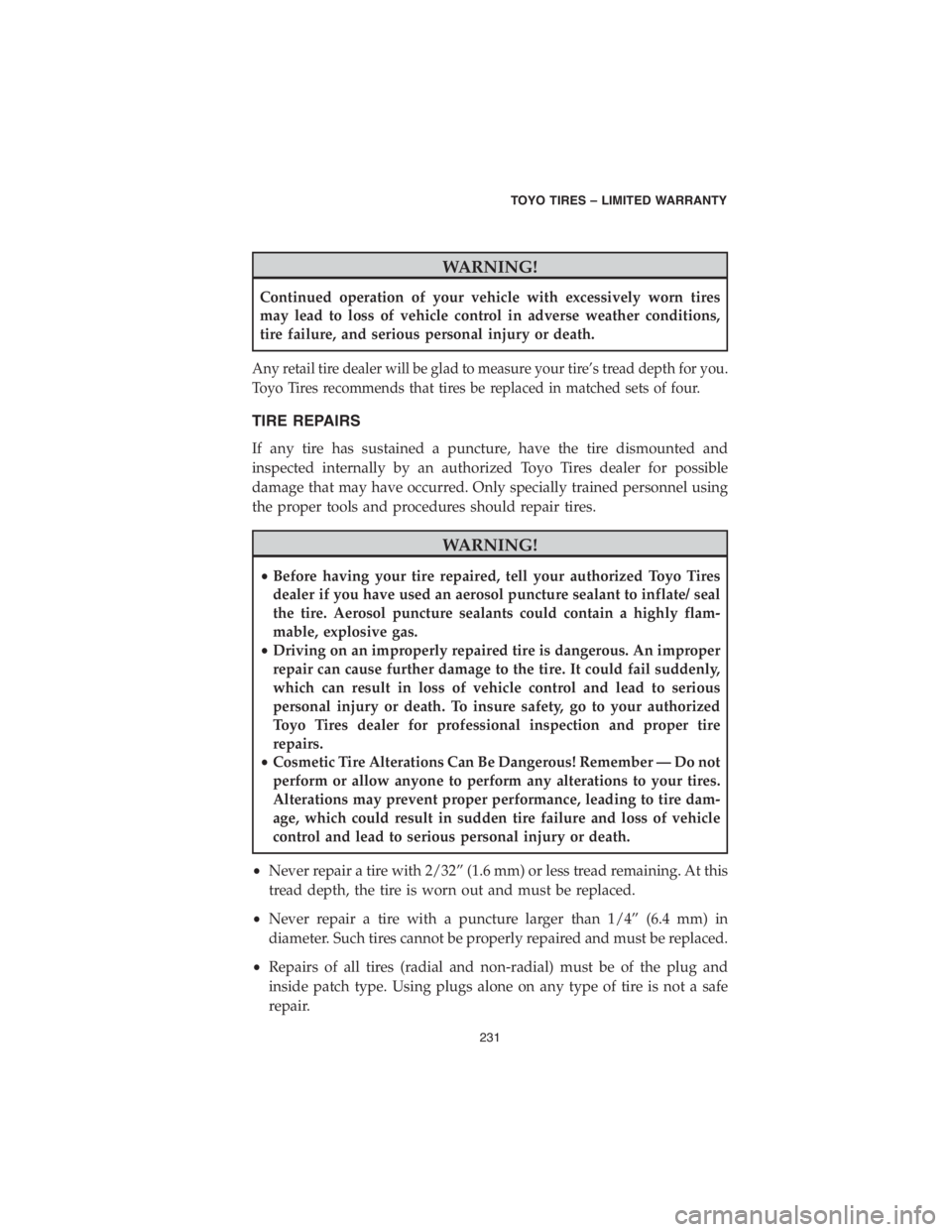
WARNING!
Continued operation of your vehicle with excessively worn tires
may lead to loss of vehicle control in adverse weather conditions,
tire failure, and serious personal injury or death.
Any retail tire dealer will be glad to measure your tire’s tread depth for you.
Toyo Tires recommends that tires be replaced in matched sets of four.
TIRE REPAIRS
If any tire has sustained a puncture, have the tire dismounted and
inspected internally by an authorized Toyo Tires dealer for possible
damage that may have occurred. Only specially trained personnel using
the proper tools and procedures should repair tires.
WARNING!
•Before having your tire repaired, tell your authorized Toyo Tires
dealer if you have used an aerosol puncture sealant to inflate/ seal
the tire. Aerosol puncture sealants could contain a highly flam-
mable, explosive gas.
•Driving on an improperly repaired tire is dangerous. An improper
repair can cause further damage to the tire. It could fail suddenly,
which can result in loss of vehicle control and lead to serious
personal injury or death. To insure safety, go to your authorized
Toyo Tires dealer for professional inspection and proper tire
repairs.
•Cosmetic Tire Alterations Can Be Dangerous! Remember — Do not
perform or allow anyone to perform any alterations to your tires.
Alterations may prevent proper performance, leading to tire dam-
age, which could result in sudden tire failure and loss of vehicle
control and lead to serious personal injury or death.
•Never repair a tire with 2/32” (1.6 mm) or less tread remaining. At this
tread depth, the tire is worn out and must be replaced.
•Never repair a tire with a puncture larger than 1/4” (6.4 mm) in
diameter. Such tires cannot be properly repaired and must be replaced.
•Repairs of all tires (radial and non-radial) must be of the plug and
inside patch type. Using plugs alone on any type of tire is not a safe
repair.
TOYO TIRES – LIMITED WARRANTY
231
Page 233 of 316
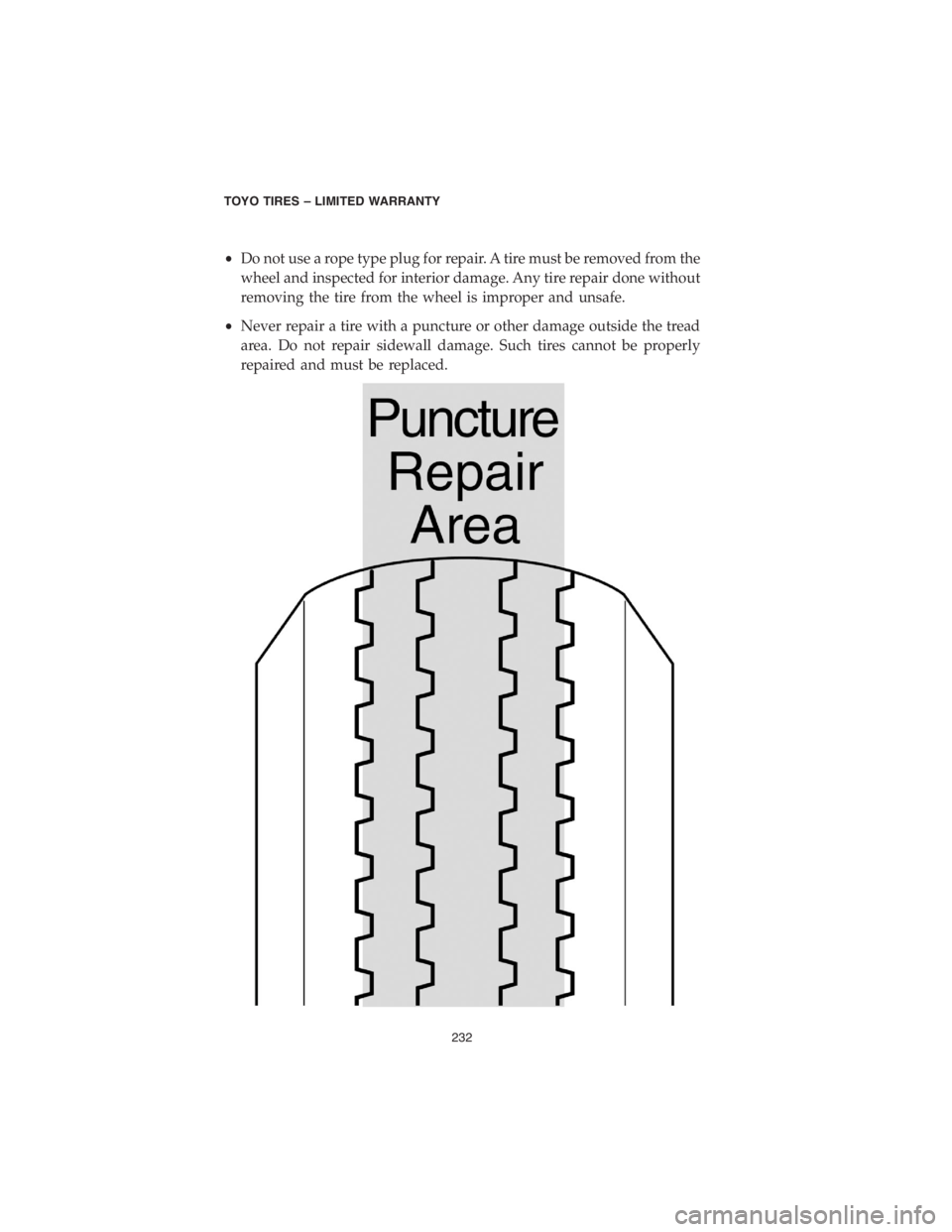
•Do not use a rope type plug for repair. A tire must be removed from the
wheel and inspected for interior damage. Any tire repair done without
removing the tire from the wheel is improper and unsafe.
•Never repair a tire with a puncture or other damage outside the tread
area. Do not repair sidewall damage. Such tires cannot be properly
repaired and must be replaced.
TOYO TIRES – LIMITED WARRANTY
232
Page 236 of 316
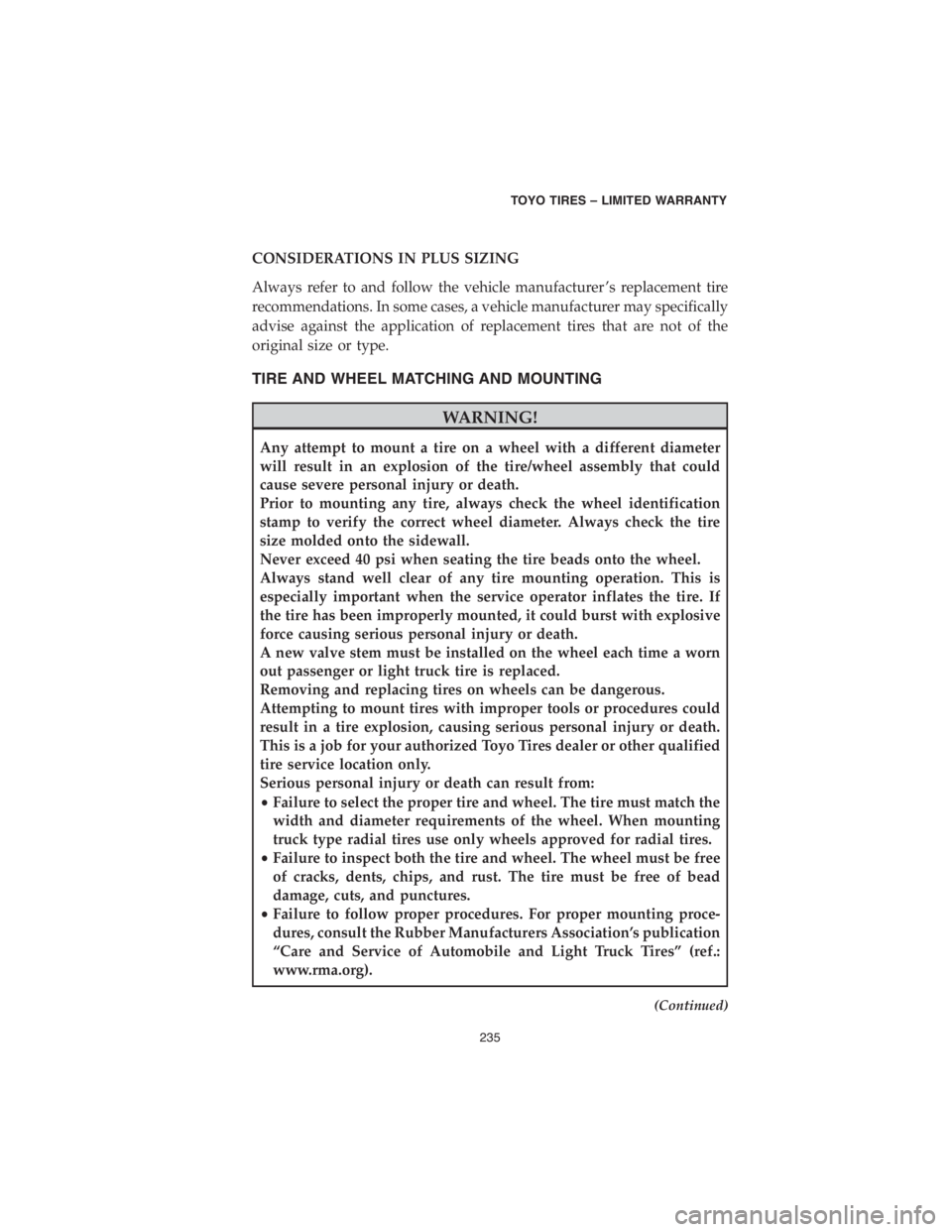
CONSIDERATIONS IN PLUS SIZING
Always refer to and follow the vehicle manufacturer ’s replacement tire
recommendations. In some cases, a vehicle manufacturer may specifically
advise against the application of replacement tires that are not of the
original size or type.
TIRE AND WHEEL MATCHING AND MOUNTING
WARNING!
Any attempt to mount a tire on a wheel with a different diameter
will result in an explosion of the tire/wheel assembly that could
cause severe personal injury or death.
Prior to mounting any tire, always check the wheel identification
stamp to verify the correct wheel diameter. Always check the tire
size molded onto the sidewall.
Never exceed 40 psi when seating the tire beads onto the wheel.
Always stand well clear of any tire mounting operation. This is
especially important when the service operator inflates the tire. If
the tire has been improperly mounted, it could burst with explosive
force causing serious personal injury or death.
A new valve stem must be installed on the wheel each time a worn
out passenger or light truck tire is replaced.
Removing and replacing tires on wheels can be dangerous.
Attempting to mount tires with improper tools or procedures could
result in a tire explosion, causing serious personal injury or death.
This is a job for your authorized Toyo Tires dealer or other qualified
tire service location only.
Serious personal injury or death can result from:
•Failure to select the proper tire and wheel. The tire must match the
width and diameter requirements of the wheel. When mounting
truck type radial tires use only wheels approved for radial tires.
•Failure to inspect both the tire and wheel. The wheel must be free
of cracks, dents, chips, and rust. The tire must be free of bead
damage, cuts, and punctures.
•Failure to follow proper procedures. For proper mounting proce-
dures, consult the Rubber Manufacturers Association’s publication
“Care and Service of Automobile and Light Truck Tires” (ref.:
www.rma.org).
(Continued)
TOYO TIRES – LIMITED WARRANTY
235
Page 238 of 316
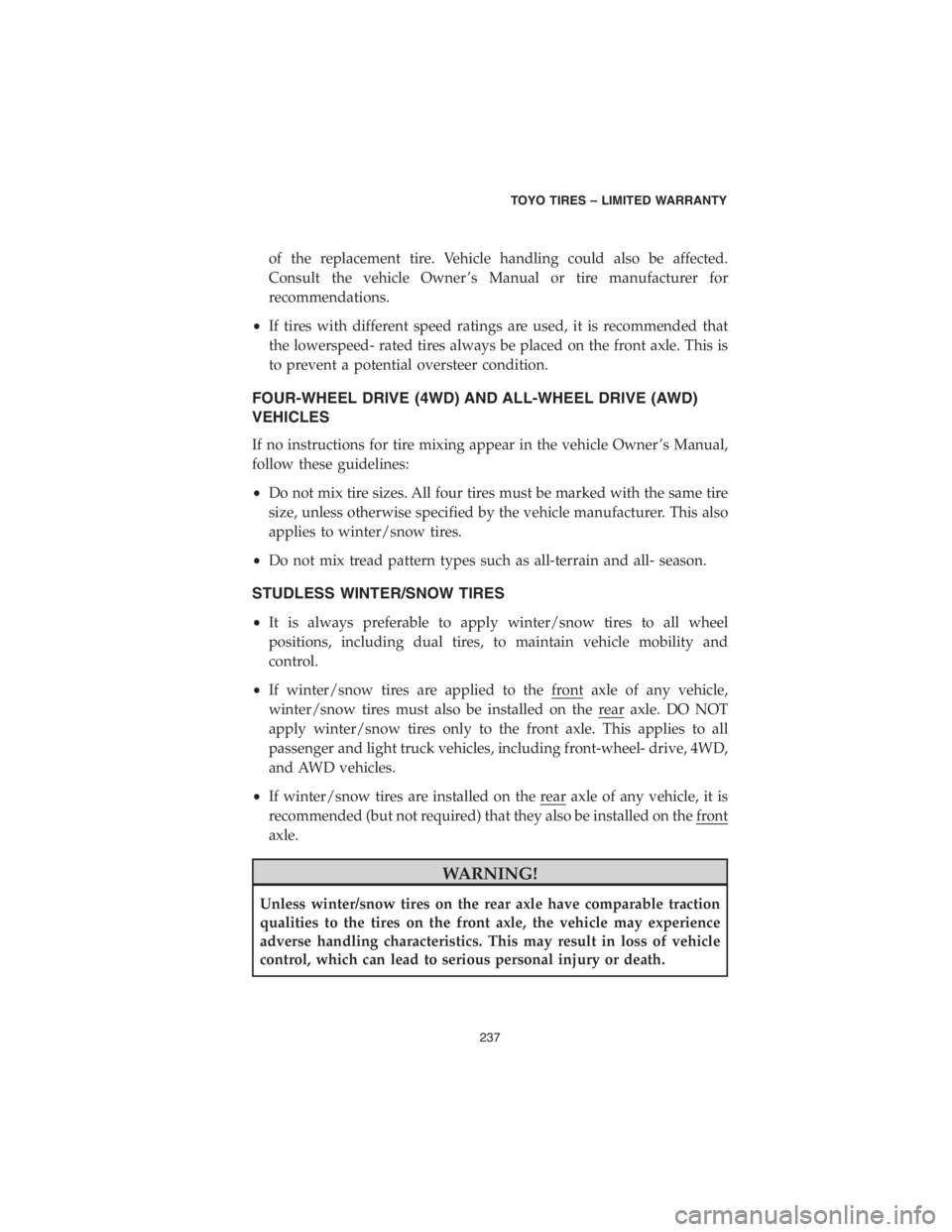
of the replacement tire. Vehicle handling could also be affected.
Consult the vehicle Owner ’s Manual or tire manufacturer for
recommendations.
•If tires with different speed ratings are used, it is recommended that
the lowerspeed- rated tires always be placed on the front axle. This is
to prevent a potential oversteer condition.
FOUR-WHEEL DRIVE (4WD) AND ALL-WHEEL DRIVE (AWD)
VEHICLES
If no instructions for tire mixing appear in the vehicle Owner ’s Manual,
follow these guidelines:
•Do not mix tire sizes. All four tires must be marked with the same tire
size, unless otherwise specified by the vehicle manufacturer. This also
applies to winter/snow tires.
•Do not mix tread pattern types such as all-terrain and all- season.
STUDLESS WINTER/SNOW TIRES
•It is always preferable to apply winter/snow tires to all wheel
positions, including dual tires, to maintain vehicle mobility and
control.
•If winter/snow tires are applied to the front axle of any vehicle,
winter/snow tires must also be installed on the rear axle. DO NOT
apply winter/snow tires only to the front axle. This applies to all
passenger and light truck vehicles, including front-wheel- drive, 4WD,
and AWD vehicles.
•If winter/snow tires are installed on the rear axle of any vehicle, it is
recommended (but not required) that they also be installed on the front
axle.
WARNING!
Unless winter/snow tires on the rear axle have comparable traction
qualities to the tires on the front axle, the vehicle may experience
adverse handling characteristics. This may result in loss of vehicle
control, which can lead to serious personal injury or death.
TOYO TIRES – LIMITED WARRANTY
237
Page 244 of 316
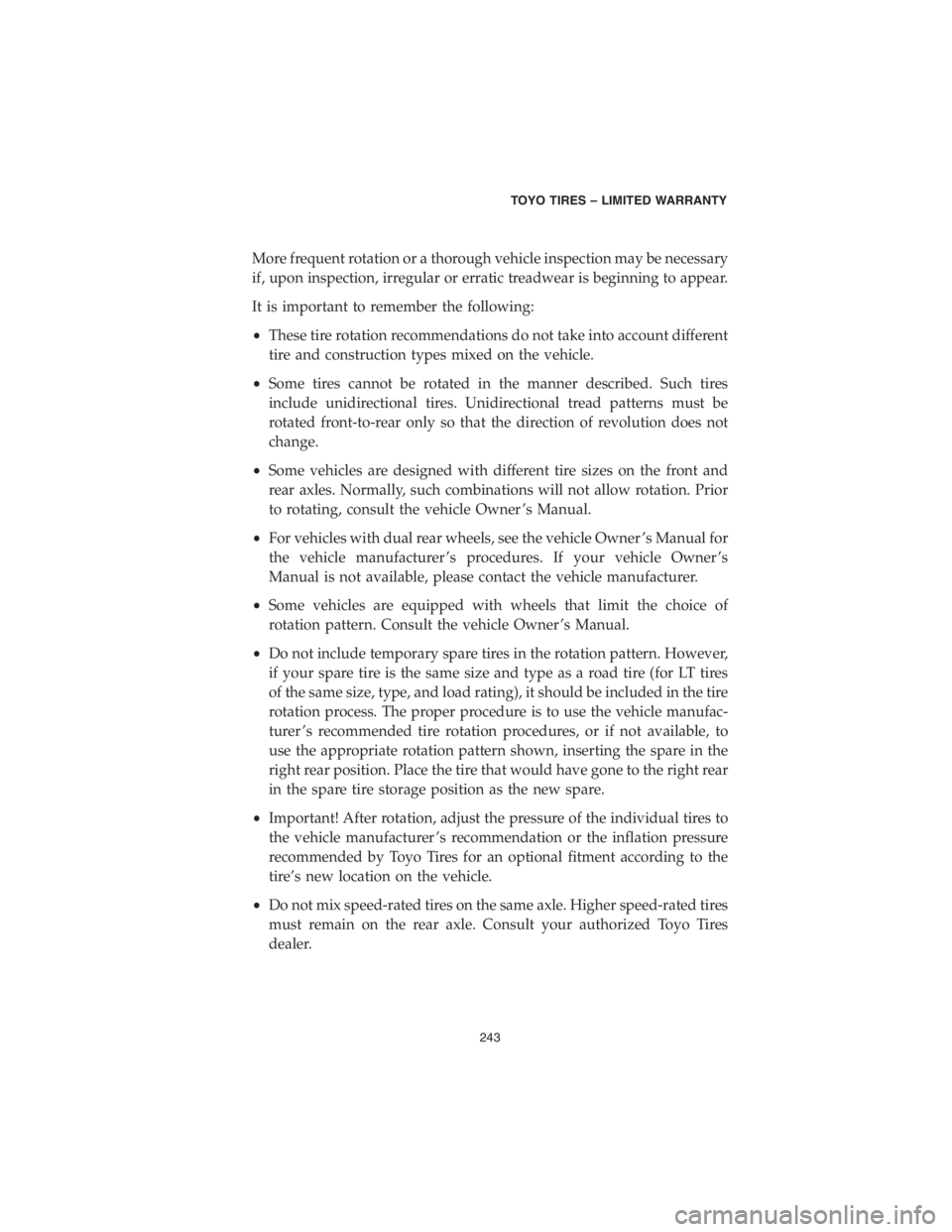
More frequent rotation or a thorough vehicle inspection may be necessary
if, upon inspection, irregular or erratic treadwear is beginning to appear.
It is important to remember the following:
•These tire rotation recommendations do not take into account different
tire and construction types mixed on the vehicle.
•Some tires cannot be rotated in the manner described. Such tires
include unidirectional tires. Unidirectional tread patterns must be
rotated front-to-rear only so that the direction of revolution does not
change.
•Some vehicles are designed with different tire sizes on the front and
rear axles. Normally, such combinations will not allow rotation. Prior
to rotating, consult the vehicle Owner ’s Manual.
•For vehicles with dual rear wheels, see the vehicle Owner ’s Manual for
the vehicle manufacturer ’s procedures. If your vehicle Owner ’s
Manual is not available, please contact the vehicle manufacturer.
•Some vehicles are equipped with wheels that limit the choice of
rotation pattern. Consult the vehicle Owner ’s Manual.
•Do not include temporary spare tires in the rotation pattern. However,
if your spare tire is the same size and type as a road tire (for LT tires
of the same size, type, and load rating), it should be included in the tire
rotation process. The proper procedure is to use the vehicle manufac-
turer ’s recommended tire rotation procedures, or if not available, to
use the appropriate rotation pattern shown, inserting the spare in the
right rear position. Place the tire that would have gone to the right rear
in the spare tire storage position as the new spare.
•Important! After rotation, adjust the pressure of the individual tires to
the vehicle manufacturer ’s recommendation or the inflation pressure
recommended by Toyo Tires for an optional fitment according to the
tire’s new location on the vehicle.
•Do not mix speed-rated tires on the same axle. Higher speed-rated tires
must remain on the rear axle. Consult your authorized Toyo Tires
dealer.
TOYO TIRES – LIMITED WARRANTY
243
Page 245 of 316
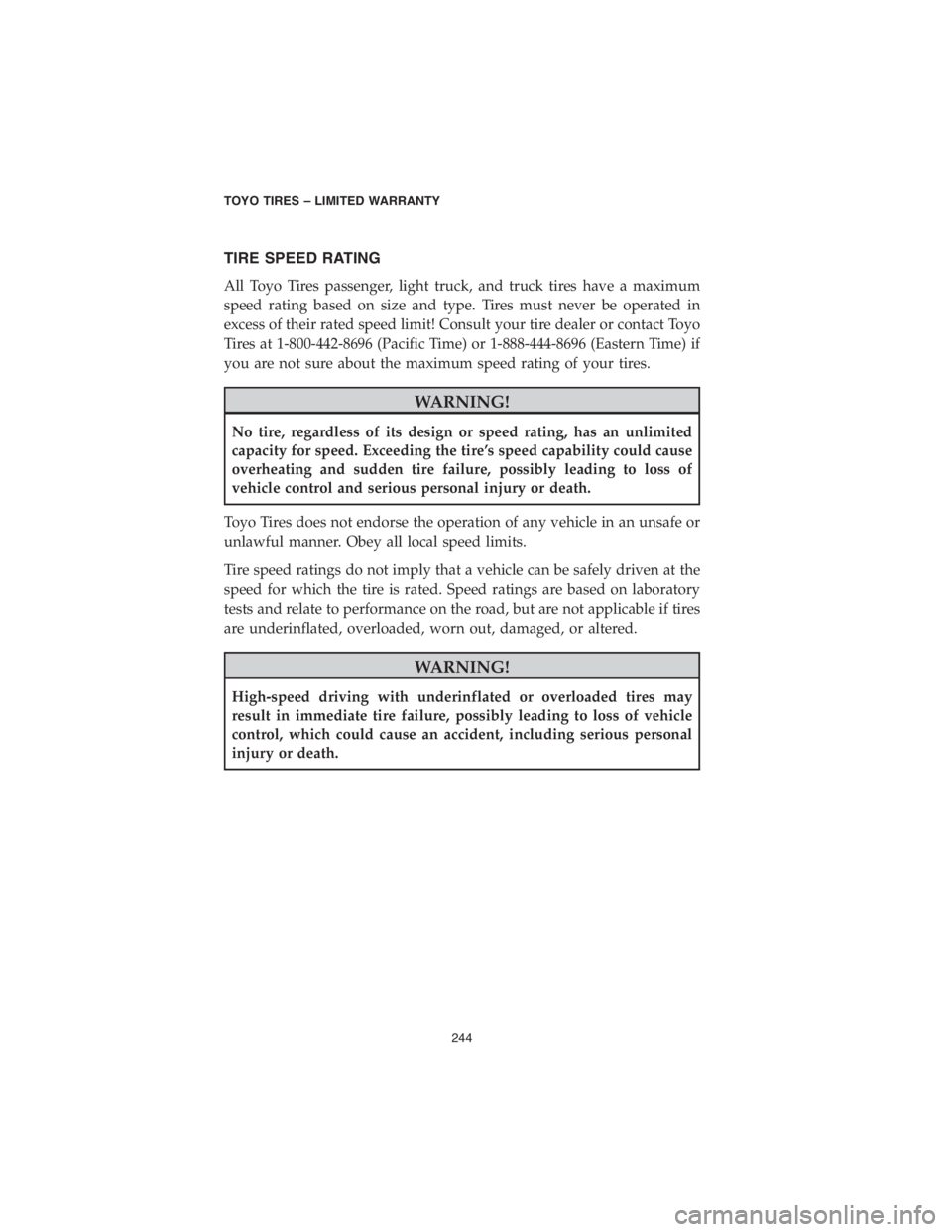
TIRE SPEED RATING
All Toyo Tires passenger, light truck, and truck tires have a maximum
speed rating based on size and type. Tires must never be operated in
excess of their rated speed limit! Consult your tire dealer or contact Toyo
Tires at 1-800-442-8696 (Pacific Time) or 1-888-444-8696 (Eastern Time) if
you are not sure about the maximum speed rating of your tires.
WARNING!
No tire, regardless of its design or speed rating, has an unlimited
capacity for speed. Exceeding the tire’s speed capability could cause
overheating and sudden tire failure, possibly leading to loss of
vehicle control and serious personal injury or death.
Toyo Tires does not endorse the operation of any vehicle in an unsafe or
unlawful manner. Obey all local speed limits.
Tire speed ratings do not imply that a vehicle can be safely driven at the
speed for which the tire is rated. Speed ratings are based on laboratory
tests and relate to performance on the road, but are not applicable if tires
are underinflated, overloaded, worn out, damaged, or altered.
WARNING!
High-speed driving with underinflated or overloaded tires may
result in immediate tire failure, possibly leading to loss of vehicle
control, which could cause an accident, including serious personal
injury or death.
TOYO TIRES – LIMITED WARRANTY
244